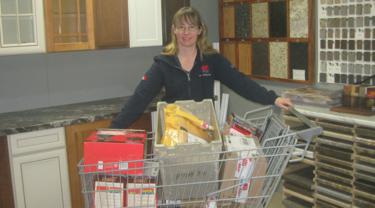LumberMart, a hardware building supply and housewares store in Halifax, established an eBay sales channel to help augment revenues during slow months. It worked. Online sales manager Kimberley Wotherspoon discusses best practices with ExportWise.
Learn more about LumberMart’s export journey here.
What was your first export sale?
I honestly can’t remember, but I would guess it was likely an eco-stove fan — it’s a fan that distributes the heat and it’s actually powered by the heat of a wood stove. I would say it likely went to the U.K. or a Scandinavian country; that’s where the bulk of them go.
How did that first export opportunity arise?
Through eBay.
When it comes to exports, what do you know now that you wish you knew then?
Knowing the ins and outs of shipping costs and pitfalls would have been helpful in the beginning.
How has the trading world changed since you started in business?
It’s only been a short amount of time, so I haven’t seen a lot of change. We see a little bit more activity from Europe because the exchange rate went down. It’s the same story with the U.S. because even when they factor in the shipping, it’s still cheaper because of the exchange.
What is the #1 thing new SMEs need to know about export and trade?
Definitely knowing shipping costs. That’s the main cost of doing business outside of Canada — getting different quotes from shipping companies. In our case, it’s the customer who pays, but our prices need to be competitive. At the same time, you don’t want to lose money on the shipping costs.
When and why did you first start thinking about exporting as part of your business?
It was when we set up the online store in 2014. How much we sell outside of Canada has been a surprise for us. A full 60 per cent of what we sell goes outside of Canada. You put your products online and all of a sudden, you have a global audience. Just today I had sales to Australia, Mauritius, the U.K., the Czech Republic, and Slovakia. And, of course, to the U.S. and Canada. I enjoy the aspect of never knowing where you might get a sale from every day.
What is the biggest difference between selling in Canada and selling in another country? How did you adapt to that difference?
With selling online, I don’t really see a difference. It’s really just marking a tick for customs information, for example, that differentiates exporting retail online from selling online in Canada. Wherever they want the product to go, we’ll ship it.
What have you learned from exporting that has benefitted your sales/operations in Canada?
I think customer service has been a key factor in our success. Online, we never see the person; it’s all in writing. You want the online customers to come back so you treat them well, just as we do with shoppers in our bricks and mortar store.
Can you share the best lesson learned from a bad exporting experience?
For international shipping, if you can, get tracking. Very rarely do we have items that don’t arrive, but there are certain countries, in Asia, for example, where things don’t always. Canada Post doesn’t automatically have tracking and there can be a significant surcharge for it, but sometimes it’s worth it.
Also, letting customers know the expected delivery time is important. Surface post might be cheaper for Australians, but it will mean they get their package in three months, not two weeks. We state it, but not everyone reads everything in the sales notes. So I’d say to make sure you make the delivery costs and time clear up front and if you can, get tracking. If it’s a power tool that costs $200, I’ll get tracking, but for a $5 item, I won’t.
What is the one characteristic that you believe every exporter should possess?
A drive to succeed. For me, selling online is what I do and what I love to do. In our case you’re never going to meet your customer in person, but you can still give them good customer service. They’ve found you, so make sure they’re happy that they made the decision to buy from you. Word of mouth is important even in online retail. We had sales in for the same item in three different cities in one day because they were friends and had been talking. The product was a “no-junk-mail” sign.





